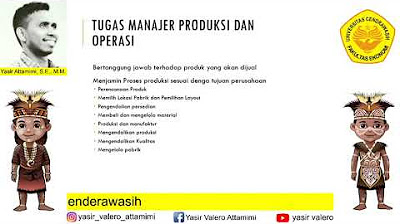Strategi Tata Letak
Summary
TLDRThis lecture provides an in-depth exploration of company layout strategies, focusing on how effective layout decisions impact operational efficiency. The instructor outlines seven types of layouts: office, retail store, warehouse, fixed-position, process-oriented, cellular, and product-oriented. Each layout approach is explained in terms of its relevance to different business contexts. The lecture also covers key concepts such as cycle time, workstation efficiency, and network diagrams, offering practical examples and formulas to guide calculations. The session concludes with a prayer and an invitation to discuss any questions, ensuring a comprehensive understanding of these critical strategies.
Takeaways
- 😀 The lecture starts with a prayer for blessings and a focus on company layout strategy.
- 😀 Company layout strategy is essential for long-term operational efficiency, involving decisions on machine and workstation placements.
- 😀 An effective layout supports organizational strategies like cost differentiation, low-cost operations, and fast response times.
- 😀 The lecture outlines seven types of layout strategies: office, retail store, warehouse, fixed position, process-oriented, cellular, and product-oriented layouts.
- 😀 Office layout focuses on optimizing the arrangement of workers, equipment, and space to enhance the flow of information.
- 😀 Retail store layout aims to strategically place shelves and displays to respond quickly to customer behavior.
- 😀 Warehouse layout maximizes space and material handling systems for improved storage and retrieval operations.
- 😀 Fixed position layout is used for large projects where the product cannot be moved, such as shipbuilding or large construction projects.
- 😀 Process-oriented layout is best suited for low-volume, high-variation production, where processes are grouped based on similarity.
- 😀 Product-oriented layout minimizes assembly line imbalance, focusing on optimizing machine and worker utilization in repetitive production processes.
Q & A
What is the primary focus of the lecture discussed in the transcript?
-The primary focus of the lecture is on company layout strategies, including the differences between location selection and layout strategies, as well as approaches for optimizing various layouts in different types of facilities.
What are the key types of layout approaches discussed in the lecture?
-The key types of layout approaches discussed are office layout, retail store layout, warehouse layout, fixed-position layout, process-oriented layout, cellular layout, and product-oriented layout.
How does office layout contribute to operational efficiency?
-Office layout focuses on the arrangement of workers, equipment, and office space to improve the flow of information, enhancing communication and reducing inefficiencies in work processes.
What is the purpose of the product-oriented layout?
-The purpose of the product-oriented layout is to optimize the utilization of workers and machines in high-volume, repetitive production systems, minimizing bottlenecks and ensuring smooth, continuous production.
What is cycle time, and how is it calculated?
-Cycle time is the amount of time required to produce one unit of output. It is calculated by dividing the total production time per day by the number of units produced per day. For example, with 480 minutes of production time and 40 units, the cycle time would be 12 minutes.
How is the number of workstations determined in production planning?
-The number of workstations is determined by dividing the total task time by the cycle time. For instance, if the total task time is 66 minutes and the cycle time is 12 minutes, the number of workstations required would be 5.5, which rounds to 6 workstations.
What formula is used to calculate the efficiency of a production system?
-Efficiency is calculated using the formula: Efficiency = (Total Task Time) / (Number of Workstations × Cycle Time). For example, if the total task time is 66 minutes and there are 6 workstations with a cycle time of 12 minutes, the efficiency would be 92%.
Why is task sequencing important in production planning?
-Task sequencing is crucial because it ensures that tasks are completed in the correct order, minimizing delays and preventing inefficiencies. Proper sequencing helps in managing dependencies, such as Task B needing to follow Task A.
What is the significance of fixed-position layout in large projects?
-Fixed-position layout is significant for large, space-consuming projects such as shipbuilding and construction, where the product remains in one location, and resources and workers are brought to the site as needed.
How does the cellular layout benefit production processes?
-Cellular layout benefits production by organizing machinery and equipment into cells focused on the production of similar products or product groups, which enhances efficiency, reduces transportation time, and improves product flow.
Outlines

هذا القسم متوفر فقط للمشتركين. يرجى الترقية للوصول إلى هذه الميزة.
قم بالترقية الآنMindmap

هذا القسم متوفر فقط للمشتركين. يرجى الترقية للوصول إلى هذه الميزة.
قم بالترقية الآنKeywords

هذا القسم متوفر فقط للمشتركين. يرجى الترقية للوصول إلى هذه الميزة.
قم بالترقية الآنHighlights

هذا القسم متوفر فقط للمشتركين. يرجى الترقية للوصول إلى هذه الميزة.
قم بالترقية الآنTranscripts

هذا القسم متوفر فقط للمشتركين. يرجى الترقية للوصول إلى هذه الميزة.
قم بالترقية الآنتصفح المزيد من مقاطع الفيديو ذات الصلة

DESAIN TATA LETAK (LAYOUT DESIGN)

LO007: 6a Warehouse Layout

Manajemen Kantor - Layout Kantor

Strategi dan Design Supply Chain Management (SCM) - Benny Oloando Tampubolon

(PART 13) - MEMBUAT PLANOGRAM : 2. Membuat Layout Retail : Tujuan, Manfaat dan Jenis Layout

Materi kuliah Pengantar Bisnis, Pertemuan Ke-5
5.0 / 5 (0 votes)
